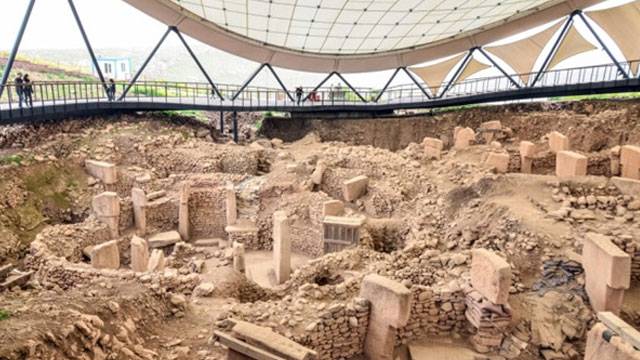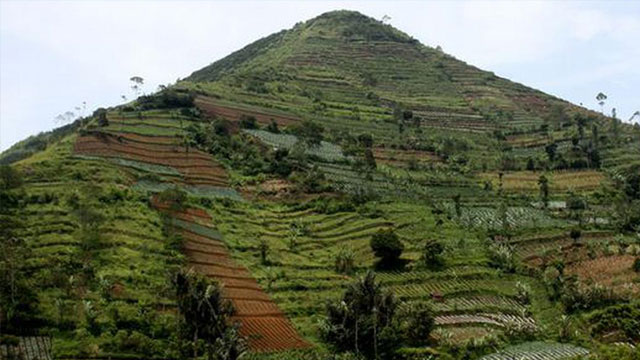Searching For Atlantis Led Me Here
According to mainstream archeologists, Atlantis is a myth made up by Plato, yet the Greek philosopher who defines his Republic as a fictional utopia would not in the case of Timaeus and Critias have the same consideration for his readers? Sollon was related to Plato; his visit to Egypt in 600 BC is a recorded historical event; the date at which the destruction of Atlantis coincides with the abrupt climate catastrophe of the Younger Dryas which was only discovered in 1904 and proven a decade later. There are too many concordant details to be a mere coincidence. When archeologists refuse to accept evidence and test theories that disprove the dominant history theory of mankind they lose the right to call themselves scientists as they abandon the pursuit of the truth and fail to help us remember what was there before the great flood story that is enshrined in every culture on the planet.
Where Is Atlantis?
I am part of the people who hypothesize that what’s left of the capital city of Atlantis is the Richat structure in Mauritania, not too far from the Atlas mountains which share the same name as the king of the lost empire.
Ancient Wonders
This group features remarkable archaeological wonders from various regions, including some of the oldest known structures and iconic monuments.
Giza
Giza is a renowned site in Egypt known for the Great Pyramid of Khufu and other pyramids. According to mainstream archaeology, these structures were built during the Old Kingdom period, around 2500 BCE, serving as tombs for pharaohs.
Theory: The younger the pyramid, the worse the construction which would imply that the old ones were built using techniques lost or unknown. Furthermore, Egyptians attribute their construction to the Kemmet people; not the Dynastic Egyptians; there are no hieroglyphs or tombs found in Giza.
Petra
Petra is an ancient city in Jordan, famous for its rock-cut architecture and stunning façades. Mainstream archaeological claims date its origins to around the 4th century BCE when it served as an essential trade and cultural hub for the Nabatean people.
Theory: If you’ve been to Petra, you’ll understand the impossibility of humans to build this with copper tools. The Nabateans, like the Romans, found Petra and made changes to it but none of them have claimed to be the original builders.
Göbekli Tepe
Göbekli Tepe is an ancient archaeological site located in Turkey, characterized by massive stone pillars arranged in circular enclosures. According to mainstream archaeology, it is believed to be one of the oldest known religious complexes, dating back to around 9600 BCE.
Theory: This is the canary in the coal mine; this structure’s construction and carved features should force any archeologist seeking the truth to question the known history of our people.
Pre-Columbian & Mesoamerican Sites
This set showcases significant archaeological sites from the pre-Columbian and Mesoamerican civilizations, each with its unique cultural and historical significance.
Cholula
The Cholula pyramid, located in the Mexican state of Puebla, is one of the largest and most remarkable archaeological sites in the Americas. Mainstream archaeology dates its construction to ancient Mesoamerican civilizations, particularly the Olmec and later the Maya and Toltec, with final stages completed by the Cholula civilization.
Theory: The largest pyramid in the world that is was discovered in 1904 and built on top of other pyramids that were built by a civilization we don’t even know how they called themselves as Olmecs is what the Mayans called them.
Machu Picchu
Machu Picchu is an iconic Inca archaeological site located in the Andes of Peru. Mainstream archaeological consensus places its construction in the 15th century, serving as an estate for the Inca emperor Pachacuti.
Theory: The consensus fails to explain how it was built. There’s a difference between being built and occupied; it also fails to explain how the oldest parts feature more advanced engineering than the youngest.
Chichén Itzá
Chichén Itzá is a Maya archaeological site located in Mexico, featuring the iconic El Castillo pyramid and other structures. Mainstream archaeological claims describe it as a prominent Maya city with cultural and astronomical significance, active during the Postclassic period from the 10th to the 15th centuries.
Theory: As lidar technology improves, we’re discovering more and more of this pyramid which is really a two-pyramids complex. There’s so much we don’t even understand about Mayan culture.
Asian & Southeast Asian Archaeological Sites
These sites are notable for their rich history, diverse architecture, and cultural importance, representing Asian and Southeast Asian archaeological heritage.
Angkor Wat
The Angkor Archaeological Park in Cambodia encompasses the remains of the Khmer Empire, including the famous Angkor Wat temple. Mainstream archaeological understanding places its construction in the 12th century during the reign of King Suryavarman II.
Theory: The more we discover about the structure, the more we understand how advanced some of the water structures and irrigation were for their time; so much so that its construction date is worth questioning.
Gunung Padang
Gunung Padang is an archaeological site in Indonesia featuring megalithic structures. Mainstream archaeological understanding places its construction in the Bronze Age (around 3,000 to 700 BCE).
Theory: That’s a wildly large estimation of the date range but of course, it’s not an estimation that contradicts the established mainstream timeline. Based on how wide that date range is, couldn’t it be older?
Borobudur
Borobudur is the largest Buddhist temple in the world, situated in Indonesia, featuring a massive stupa and terraces. According to mainstream archaeology, it was constructed in the 9th century CE and serves as a significant Buddhist pilgrimage site.
Theory: No one has claimed the build of the enormous structure. If this was built as a Buddhist temple, there would be a recollection of its creation. The Buddhist iconography is in a style different than the original structure and built using different construction methods.
Megalithic & Controversial Sites
This group encompasses megalithic structures and sites that have generated controversy and alternative theories, often sparking debates within the archaeological community.
Ġgantija
Ġgantija, located in Malta, is a megalithic temple complex that dates back to the Neolithic period, approximately 3600 BCE. Mainstream archaeology recognizes it as one of the oldest freestanding stone structures in the world, constructed by the ancient inhabitants of Malta.
Theory: Some of the scale and engineering needed to construct these structures are an impossibility for a rudimentary civilization as the one mainstream archeologists believe humans to be at the time.
Puma Punku
Puma Punku is part of the Tiwanaku complex in Bolivia, characterized by intricately carved stone blocks and megalithic architecture. Mainstream archaeology dates its construction to around 500 to 600 CE, during the Tiwanaku culture.
Theory: Giving a date without providing a technological understanding of how these structures were built puts into question when they were built with what tools.
Rapa Nui
Rapa Nui, commonly known as Easter Island, is famous for its massive stone statues, Moai, and unique archaeological features. Mainstream archaeology attributes the carving of Moai to the Rapa Nui people between the 13th and 16th centuries.
Theory: The Polynesian people who are considered indigenous to Easter Island have no record of building the Moais, the more likely explanation is they found them when they settled on the island which is considered by some as one of the last vestiges of the lost continent of Mu.
Underground Enigmas
This group encompasses archaeological sites that lead us into the hidden depths of the Earth, revealing the mysteries of subterranean wonders.
Derinkuyu
Derinkuyu is an extraordinary underground city located in Cappadocia, Turkey. Mainstream archaeological understanding dates the city to the Byzantine period, around the 7th to 8th centuries as a refuge and protection from external threats.
Theory: Derinkuyu boasts a network of tunnels, chambers, living quarters, and even a ventilation system, showcasing advanced engineering and architectural skills that the Byzantines did not have.
Lascaux
The Lascaux Caves, nestled in southwest France, are renowned for their extraordinary prehistoric cave paintings. Mainstream archaeological understanding dates the creation of these remarkable artworks to the Upper Paleolithic period, approximately 17,000 years ago.
Theory: If no one argues the age of the drawings, their meaning is disputed; some highlight uncanny details between animals depicted and constellations representing the same animals which would imply that our way of representing zodiac animals predates what is commonly accepted.
Longyou
The Longyou caves are a series of artificial caves in Zhejiang, China, believed to date back to around 200 BCE. Mainstream archaeology identifies them as remarkable feats of ancient engineering and quarrying, most likely created to extract sandstone.
Theory: No one knows how and why these caves were created. All around the world, gigantic subterranean structures are discovered that should have been impossible to create for a civilization of hunter-gatherers.
Built On The Remnant Of The Past
These sites showcase the incredible resilience of human civilizations as they constructed their wonders atop the foundations of ancient heritage.
Baalbek
Baalbek, located in Lebanon, is known for its Roman temple complex, particularly the massive stone blocks of the Trilithon. Mainstream archaeological consensus attributes the construction to the Romans in the 1st century CE.
Theory: There is absolutely no doubt, that the Romans built the temple; however, the foundations made of gigantic stone blocks are unlike any structure built by them and they didn’t have the technology to do it.
Ain Dara
The Ain Dara Temple, located in northwest Syria is renowned for its intricate basalt-carved animal figures, colossal footprints, and a central chamber with a large central image. Mainstream archaeology dates the temple to the Iron Age, around the 10th to 8th centuries BCE, associating it with the Aramean culture.
Theory: The Aramean did not have the craftsmanship and technological skills required to build a black basalt structure which isn’t found in the region; the temple they built was destroyed by Turkish bombings meanwhile the basalt base they built their temple on top of still remains.
Sacsayhuamán
Sacsayhuamán, situated in the highlands of Peru, near Cusco, is an exceptional megalithic stone structure. Mainstream archaeology dates its construction to the Inca Empire during the 15th century.
Theory: The site precisely fitted stone blocks, some weighing several tons, and the remarkable dry-stone construction demonstrate advanced engineering and architectural skills which pre-dates the Incan additions to the site.






















